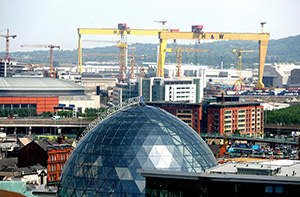Regeneration
Northern Ireland has undergone a remarkable transformation in recent years. Cities and towns that were once in decline following the departure of heavy industry have been reborn as thriving 21st century urban spaces.
New energy is pumping through Northern Ireland as government, community and private sector bodies inject new ideas into tackling social, economic and physical regeneration in our cities, towns and villages. In addition to addressing the physical infrastructure, the central goal of this work is to make real improvements in people’s lives and to provide rewarding economic opportunity.

- More than £1 billion has been invested in our social infrastructure over the last three years.
- Work has been taken forward in a number of towns and city centers improving the experience for visitors, shoppers and residents including the opening of the Victoria Square scheme in 2008 which created almost 9,000 jobs in construction and retail.
- Regeneration in the Laganside area of Belfast has continued with the completion of major residential and commercial developments including The Boat, Obel, Lanyon Towers, The Soloist and Pottinger’s Quay. The combined total private investment facilitated by these developments is estimated to be in the order of £260m.
- A major £3m restoration project to the Gatehouse and Governor’s Corridor at Crumlin Road Jail has now been completed. The work to arrest the structural deterioration of these two parts of the Jail will enable them to be brought back into public use. Facilities for visitors have been greatly enhanced and now include a comfortable waiting /shop area, a café, facilities for tour guides, office accommodation, and a 180 seat conference center. The social clauses built into this contract ensured two jobs for the long-term unemployed and one apprenticeship were created. Plans to re-open the Jail as a visitor attraction and conference center in summer 2012 are underway. This new attraction has the potential to act as a positive catalyst for social and economic regeneration in North Belfast.
- Ministers decided to create a Development Corporation to take forward the development of the Maze/Long Kesh (MLK) - a key strategic site for regional economic and social benefit. Substantial projects for both a peace building and conflict resolution center, and a center for rural excellence have been proposed and are being developed for approval.
- The opening of the Peace Bridge in Derry~Londonderry in June 2011 is part of a wider peace and reconciliation program that proactively encourages greater levels of positive engagement between all communities living within the city.
- Refurbishment of one building on the Ebrington site has provided headquarters accommodation for the Derry~Londonderry City of Culture Company; indicating tangible progress in the development of Ebrington and providing a focus for the ongoing preparations for the City of Culture 2013 events.
- By the end of 2010/11 approximately 5,000 social homes were built, supporting those in the greatest need and 1,200 individuals and families will have been helped to buy their own home through the Northern Ireland Co-ownership scheme.
- The Ulster Museum reopened its doors to the public after a significant refurbishment and is now Belfast’s busiest attraction and winner of the UK Art Fund Prize.
- The Parade Ground at Ebrington, including Cunningham Square, both of which are now open to the public, has been transform into a multi-purpose culture, leisure and performance space, larger than Trafalgar Square and will be the largest hard-surface public space in the island of Ireland. It will have the capacity to hold audiences of 15,000.
- The Metropolitan Arts Centre (MAC) in Belfast’s Cathedral Quarter and Titanic Belfast opened in March 2012.
With one of the youngest populations in Europe – 45% of our 1.8 million people are under the age of 30 – Northern Ireland is committed to delivering an education system that meets the needs of society in the 21st century.
Many cities and regions throughout North America are also undergoing small- and large-scale regeneration programs. We know from our own experience to date that Northern Ireland can learn from projects that have been completed in the United States and Canada, and we believe that exchange of knowledge can be reciprocal.
